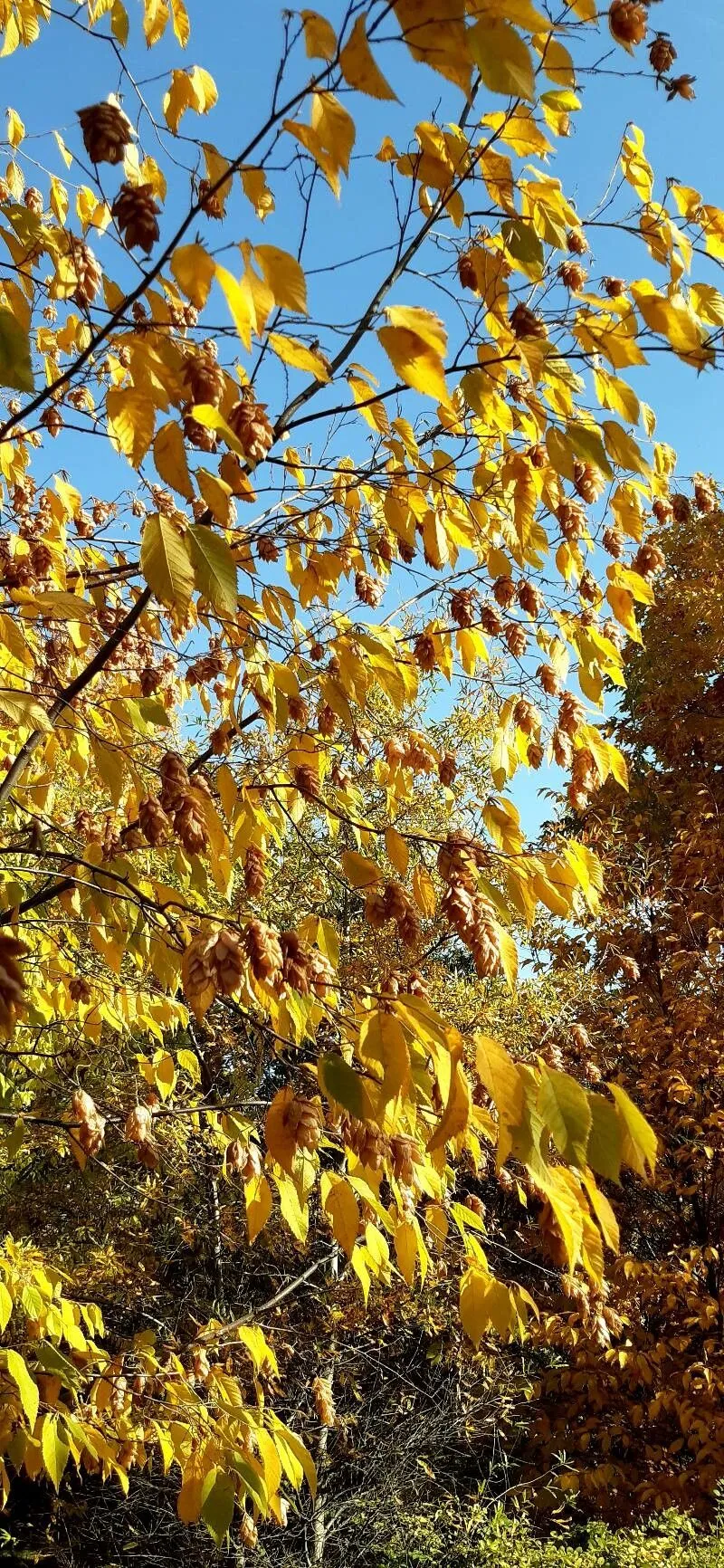
Author: (Mill.) K.Koch
Bibliography: Dendrologie 2(2): 6 (1873)
Year: 1873
Status: accepted
Rank: species
Genus: Ostrya
Vegetable: False
Observations: C. & E. Canada, C. & E. U.S.A. to Wyoming, Mexico to C. America
The American hop-hornbeam, scientifically known as Ostrya virginiana, is a notable member of the Betulaceae family. This resilient plant has a widespread habitat, thriving from Central and Eastern Canada, across the Central and Eastern United States, reaching as far west as Wyoming and extending down to Mexico and Central America.
Renowned for its distinctive appearance, the American hop-hornbeam is a deciduous tree that typically reaches heights of 50 to 75 feet. Its bark is grayish-brown, flaking into thin, vertical strips that provide a unique, somewhat shredded texture. The leaves are simple, ovate, and doubly serrated, presenting a green hue that transforms into vibrant shades of yellow in the fall, adding seasonal interest to the landscape.
One of the most remarkable features of the American hop-hornbeam is its fruiting structure, which resembles the hops used in brewing beer, hence its common name. These fruit clusters are composed of inflated, papery sacs that enclose small nuts, creating an ornamental quality that persists into winter.
Valued for its hard, durable wood, Ostrya virginiana has been employed in producing various tools and agricultural implements. Its ability to thrive in various soil types, including rocky and dry soils, makes it a versatile and resilient addition to diverse ecosystems.
Despite its hardiness, the American hop-hornbeam is relatively slow-growing, which can be a consideration for those interested in cultivating it for ornamental purposes. However, its capacity to resist pollution makes it an excellent choice for urban forestry and reforestation efforts.
First described formally in the second volume of “Dendrologie” in 1873 by botanist K. Koch, from a specimen identified by Mill., the American hop-hornbeam continues to be admired both for its aesthetic qualities and its practical applications in woodworking and ecological restoration.
Eng: american hop-hornbeam, eastern hop-hornbeam, eastern hophornbeam, hophornbeam, ironwood, american hophornbeam, eastern hop hornbeam, hop-hornbeam, leverwood
Swe: amerikansk humlebok
Fra: bois de fer, ostryer de virginie, ostryer de virdinie, bois dur, bois à levier, ostryer de la virginie
Spa: guapaque, guichin, mora, mora roja, palo blanco moro, pepinque, petatillo, pipinque, tzutujté
En: American hop-hornbeam, Eastern hop-hornbeam, Eastern hophornbeam, Hophornbeam, Ironwood, American hophornbeam, Eastern hop hornbeam, Hop-hornbeam, Leverwood
Fr: Bois de fer, Ostryer de Virginie, Ostryer de Virdinie, Bois dur, Bois à levier, Ostryer de la Virginie
Es: Guapaque, Guichin, Mora, Mora roja, Palo blanco moro, Pepinque, Petatillo, Pipinque, Tzutujté
Sv: Amerikansk humlebok
Taken Jul 10, 2021 by Lalah Godwin (cc-by-sa)
Taken Jun 20, 2021 by Sabine Roach (cc-by-sa)
Taken Sep 24, 2021 by Oliver Schmit (cc-by-sa)
Taken Jul 7, 2021 by Brent Brent (cc-by-sa)
Taken Sep 24, 2021 by Oliver Schmit (cc-by-sa)
Taken Aug 29, 2020 by Philippe de Spoelberch (cc-by-sa)
Taken Jul 24, 2022 by cassie wood (cc-by-sa)
Taken Oct 22, 2020 by Irmgard Groß (cc-by-sa)
Taken Sep 24, 2021 by Oliver Schmit (cc-by-sa)
Taken Jun 26, 2022 by Sarah Strandemo (cc-by-sa)
Taken Aug 29, 2020 by Philippe de Spoelberch (cc-by-sa)
Taken Oct 22, 2020 by Irmgard Groß (cc-by-sa)
Taken Aug 29, 2020 by Philippe de Spoelberch (cc-by-sa)
Taken Jul 9, 2020 by Natures Guy (cc-by-sa)
Taken Jun 18, 2022 by Vitezslav Duspiva (cc-by-sa)
Taken Jul 24, 2022 by cassie wood (cc-by-sa)
Taken Jul 7, 2021 by Brent Brent (cc-by-sa)
© copyright of the Board of Trustees of the Royal Botanic Gardens, Kew.
© copyright of the Board of Trustees of the Royal Botanic Gardens, Kew.
© copyright of the Board of Trustees of the Royal Botanic Gardens, Kew.
Taken Jun 13, 2020 by philippe de spoelberch (cc-by-sa)
Growth form: Single Stem
Growth habit: Tree, Shrub
Growth rate: Slow
Ph maximum: 7.6
Ph minimum: 4.2
Family: Myrtaceae Author: (F.Muell.) K.D.Hill & L.A.S.Johnson Bibliography: Telopea 6: 402 (1995) Year: 1995 Status:…
Family: Rubiaceae Author: Pierre ex A.Froehner Bibliography: Notizbl. Bot. Gart. Berlin-Dahlem 1: 237 (1897) Year:…
Family: Sapindaceae Author: Koidz. Bibliography: J. Coll. Sci. Imp. Univ. Tokyo 32(1): 38 (1911) Year:…
Family: Asteraceae Author: A.Gray Bibliography: Pacif. Railr. Rep.: 107 (1857) Year: 1857 Status: accepted Rank:…
Family: Fabaceae Author: Medik. Bibliography: Vorles. Churpfälz. Phys.-Ökon. Ges. 2: 398 (1787) Year: 1787 Status:…
Family: Aspleniaceae Author: (Cav.) Alston Bibliography: Bull. Misc. Inform. Kew 1932: 309 (1932) Year: 1932…